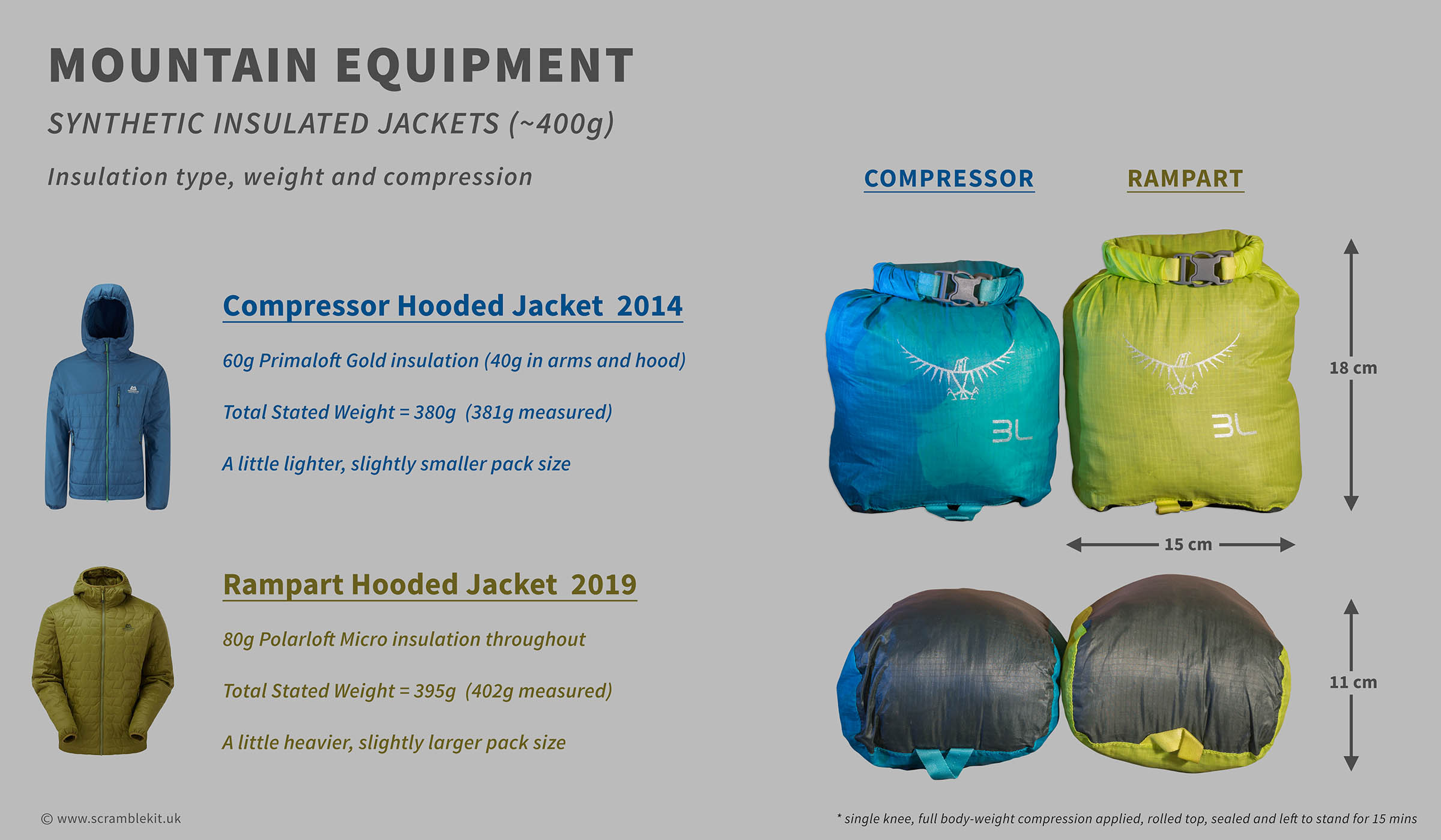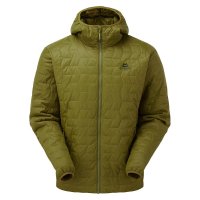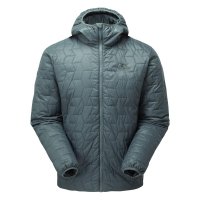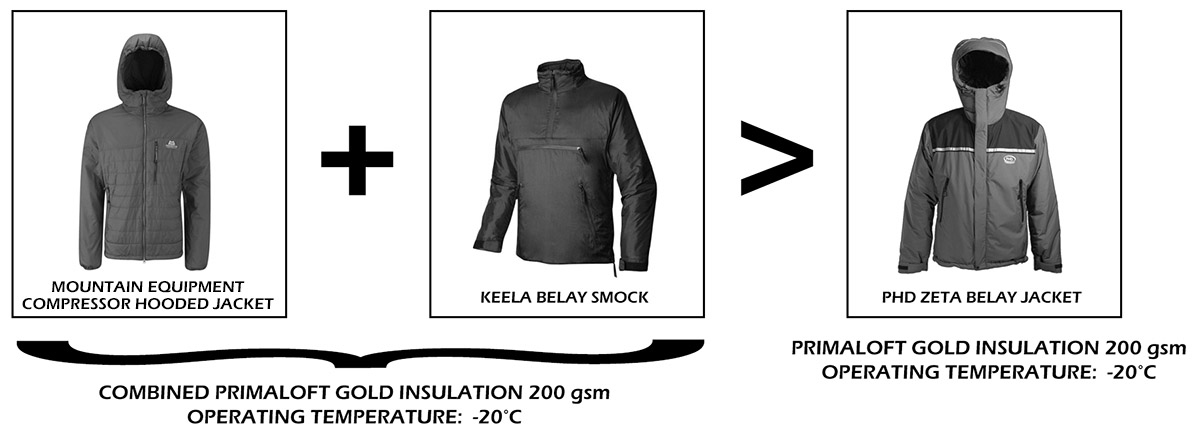This product has been toppled / discontinued
Click on the image above or here to see its replacement.
Preface
We recently wrote a post about synthetic insulation titled "A Fraud of Meaningless Measures" which serves as a companion piece to this review. It, along with our old review of the Mountain Equipment Compressor (2014), will hopefully shed light on why getting the right insulated jacket is not as easy as it might be. This is partly due to strange, self-sabotaging design choices by manufacturers, but also due to their lack of willingness to provide meaningful data for their insulation (see Why Can't We Answer This Question?). As it stands, the purchase of an insulated jacket, particularly a synthetic one is largely a matter of faith, akin to voting on a US Healthcare Bill ("we have to pass the bill so that you can find out what is in it").
As always, we're looking at the Mountain Equipment Rampart from the point of view of long distance trekking over tough terrain.
Test subject: Chest 42", Waist 33", Height: 5ft 8"
Test item: 2019 (Fir Green) version, size = Large
Kit Tests: Winter, Summer
Disclaimer: None required (item not provided by manufacturer)
Datasheet
| Outer Material: Helium 30 (Polyamide i.e. Nylon) | 100% |
| Insulation: Polarloft® Micro (Polyester) | 80g/sm |
| Weight (Size Large, Stated / Measured) | 395g / 402g |
| Product Sizing Reference: 42" Chest = | Large |
| Manufacturer RRP | £120.00 |
Scramble Review
Contents
- Introduction
- Weight & Pack-size (Compressibility)
- Value: Switching Insulation & Ditching Non-Essential Features
- Minimalism: So What Remains?
- Features
- Performance
- Any Negatives?
- Conclusion, Rating & Product Images
- Postscript: Insulation Layering Versatility
Introduction: Long Time Coming
Ever since the old Mountain Equipment Compressor (2014) made way for its ill-conceived successor, we've been looking for its replacement in the sub 400g insulated jacket category. You can see the issues we've had with a number of options in our review of the Compressor as well as our recent piece on insulation (see Public Relations in Progress) where we cast doubt on Rab's claims of warmth for the Xenon Jacket and critiqued their confused and contradictory statements regarding its stated purpose; a static belay piece.
Many jacket's have been assessed prior to this review, most have:
- ill-conceived or poorly designed hoods (e.g. Xenon, Nano Puff, Lifaloft Hooded),
- dubious performance claims for their proprietary insulation, or
- are too heavy, or
- are way too expensive, or
- all of the above
What we want from this type of jacket hasn't changed, so let's just recap:
In Scramble's opinion the point of an insulated jacket is to stop you getting too cold when you're not active; when you are active, a wind-resistant (non-thermal) outer layer is generally sufficient to keep you warm enough without overheating / sweating. Jackets like the [Rampart] are fundamentally light belay jackets; static pieces that won't weigh you down but will keep you warm when you stop.
So, what we want from a lightweight insulated jacket is:
- To weigh less than 400g (since we're carrying it much of the time)
- To be warm enough: 60g (or more) of high quality synthetic insulation (Primaloft Gold or equivalent) provides a meaningful amount of warmth - 50g or less of core insulation in our opinion is not sufficient to provide a significant effect
- To maintain much of its warmth when wet
- To be highly wind resistant (i.e. not particularly breathable)
- To have a protective hood that shelters the sides of the face
- To pack down small enough to shame a fleece
Mountain Equipment's Rampart is the closest thing to the old Compressor we've come across. There are sacrifices but there are also gains - we'll note both as we go through the review and we'll use the old (2014) Compressor as our benchmark. Before we take a look at the Rampart's general features, we'll first consider its weight and pack-size (compressibility).
Weight & Pack-size (Compressibility)
My copy of the Rampart (size Large) is 402g, but the stated weight is 395g (L). If we take the average (398.5g) then we've just squeezed under our 400g limit, so we'll cut Mountain Equipment some slack and let it in. But it's right on the limit of what we feel is acceptable for a lightweight insulation piece.
The Rampart has 80g/sm of Mountain Equipment's Polarloft Micro insulation. How effective is that when compared to Primaloft Gold? No one knows ...
The reason we cannot know is because no one knows how each of these synthetic insulations perform (except perhaps the manufacturers). It's not measured, or if it is, it's not disclosed. So marketing departments can just go hog-wild with colourful copy and instead provide the impression of a useful specification and we are left taking their word for it (or not).
We'll shed some light on the insulation's performance later. However, we can be a little more specific when it comes to compressibility. In this reasonably repeatable test, the Compressor and the Rampart were stuffed into 3L Osprey Dry Bags, kneeled on with almost full body weight until all the air was removed. The roll-top was then folded over until it wouldn't fold any more, sealed and then left to sit for 15 minutes. Here's the results.
I was actually pleasantly surprised by the Rampart's compressibility. When I first got my hands on it, it seemed a little heavy; less airy than the Compressor. In actuality it's only 20g heavier and though less compressible, not by that much. It's worth noting that it is carrying more grams per square meter of insulation than the Compressor (but more grams of what exactly?).
The Value of Switching Insulation & Ditching Non-Essential Features
What the Rampart loses in terms of weight and compressibility it more than makes up for in terms of value. When the Compressor came out in 2014 it was priced at £140, its successor came in at £160. I think it's fair to assume the old 2014 Compressor would today be around £170 to £180 (RRP). Even if we stick to the £160 price of 2015, Mountain Equipment, by ditching Primaloft and a number of non-essential features (listed below), have bucked the trend and passed some of the savings onto the customer (the Rampart retails at £120). This is £40 less than Rab's Xenon Jacket (a frail re-imagining of their Xenon X).
So what features have Mountain Equipment sacrificed at the value alter? Well, to be frank the 2014 Compressor's features that are absent from the Rampart are not ones we're going to miss:
- The velcro hood roll-away attachment (I never used)
- The zippered chest pocket (I found the small internal pocket just as effective, though you could argue less secure as it has no zip)
- The two-way zipper is something that climbers with a harness would miss, but again it's not something I ever used (no one at Scramble has bemoaned its loss), I think most of us had forgotten it was there (rather like the roll-away hood).
Minimalism: So What Remains?
We've seen what's been omitted from the Rampart, so what are we left with? The answer: a very simple, pleasingly minimalist, well designed, lightweight insulation piece. The jacket is neither too fitted nor too roomy and offers good coverage below the waist with a dropped back.
 Mountain Equipment's Rampart Jacket is neither constrictive nor overly roomy.
Mountain Equipment's Rampart Jacket is neither constrictive nor overly roomy.
Here's a quick overview of its features and we'll use this as our guide as we run through them.
Features
Face Fabric
The Rampart uses the same Helium 30 face fabric as the 2014 Compressor. A lightweight, highly wind-resistant outer fabric which peculiarly seems to toughen with use. The Rampart's array of stitch-though baffles appears to be an exercise in tessellation, but I'm assuming this an artifact of their Polarloft Micro insulation being more prone to migration than Primaloft. Otherwise this is merely an aesthetic / fashion choice (I hope not).
The internal liner of course has no such stitching and so wind-proofing is not compromised. In terms of warmth, my impression (and it's just an impression) is that the Rampart is a little warmer than the Compressor. It's certainly safe to say it's at least as warm. Remember the Compressor only had 40g/sm of (a likely superior) insulation in the arms and hood, whereas the Rampart has 80g/sm (of a likely inferior insulation) throughout.
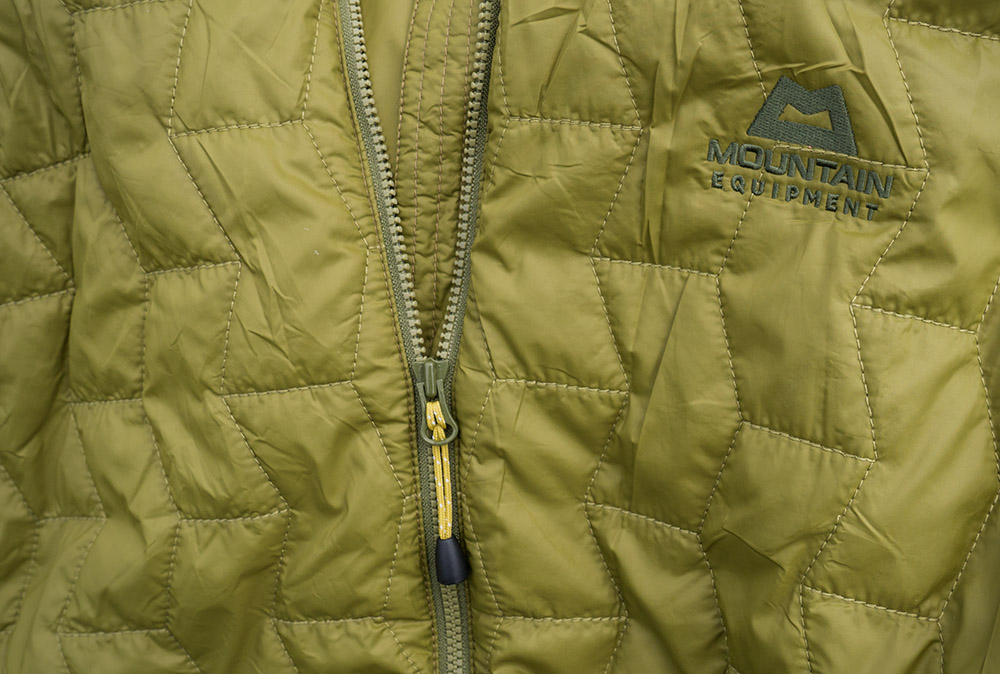 The Rampart's Helium 30 face fabric and YKK vislon zipper
The Rampart's Helium 30 face fabric and YKK vislon zipper
Above, we get a good view of the plastic molded YKK vislon zip and the (storm flap) baffle underneath to prevent heat-loss. Everything on the jacket is executed to Mountain Equipment's usual high standards and there are no signs of cost cutting whatsoever (i.e. the savings are accrued through a reduction in non-essential features, rather than a downgrading of component materials).
The Hood
We made a big deal about hoods in our review of the 2014 Compressor, so we'll spend some time focusing on this traditional bugbear.
The first thing to say, is unlike brands like Rab, Patagonia and Alpkit, Mountain Equipment have equipped their light synthetic jacket with an over-helmet hood. Importantly, it comes with a well implemented volume adjuster at the back. This has allowed Mountain Equipment to hedge their bets a little and make a hood that can accommodate a decent amount of headgear including a helmet (it fits perfectly over my Petzl Boreo) while not being overly capacious when worn, uncinched with just a light beanie.
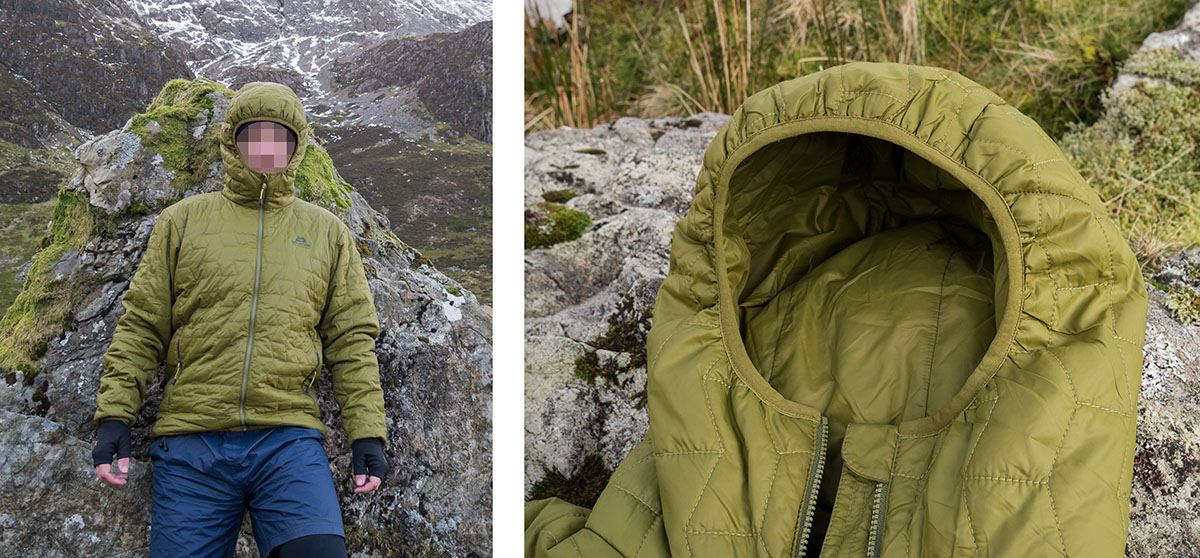 Mountain Equipment have given the Rampart a very effective hood (not common on such jackets).
Mountain Equipment have given the Rampart a very effective hood (not common on such jackets).
When in "blizzard / hunker down mode", the hood can be left uncinched (pictured below #1) and will provide sufficient protection from cross-winds. However, without a cap this does mean the head will move independently of the hood and visibility will be impaired - that's really the compromise. In such conditions I would apply some minor tightening just to keep the hood in place. When the back volume adjuster is fully employed, the hood syncs perfectly with your head but more of your face gets exposed (pictured below #2).
 The Rampart's hood: To sync or not to cinch?
The Rampart's hood: To sync or not to cinch?
For me, this kind of jacket is the only insulation piece I will have easy access to while on the move, so for brief stops in sub-zero conditions, this is my only thermal protection. I would say a balaclava is a useful accessory in extreme blizzard conditions (spin-drift etc ..) with this jacket, so the hood can be cinched up and you still have good protection over the face.
Bottom line: though at first I had my doubts, I have to say the hood is actually an improvement over the 2014 Compressor. Finally, someone's got it right!
Other minor features
Unlike the 2014 Compressor, the Rampart has no external zipped chest pocket, instead it has a simple non-zipped inner pocket (pictured below #1). Personally, I found this just as useful and though you could argue it's less secure, I don't use these pockets for anything essential anyway. Instead they're a handy place to temporarily store stuff you might lose to the undergrowth if placed on the ground (lens caps, batteries, lighters are good examples).
 The Rampart Jacket's essential features are all nicely finished.
The Rampart Jacket's essential features are all nicely finished.
The Rampart uses Mountain Equipment's dual tether hem draw-cords (one on each side, pictured above #2); a thoughtful safety measure to avoid loops which can catch when climbing. The hip adjusters are made from good quality shock-cord and the hem can be cinched in easily one-handed.
Finally, the wrists (pictured above #3) are finished in the same manner as the hood, with elastane binding. No issues here, they are robust and function well.
Almost forgot, the Rampart has two zipped hand pockets which function perfectly (same as the 2014 Compressor). Excellent zips throughout.
Performance & Function
Aside from its pack-size when stuffed, the Rampart performed very similarly to the old 2014 Compressor. As stated earlier, this is the only insulation I have to hand when on the go. Once camp is made, I'll get into my thermal sleepwear and put on a bone dry Quechua Down Gilet, then the excellent Keela Belay Smock. Most of the time, this is what I wore around camp in the 2020 winter kit test.
In extreme cold, I'll wear all three when static. The Keela (size Medium) will accommodate both the Quechua (L) and the Rampart (L). With the introduction of the super-light Quechua (just 216g, i.e. the weight of a spare winter baselayer), the Rampart is freed up to take the brunt of any hostile wet conditions during the trek.
The Rampart is warm enough to take the edge off short stops in severely cold (tested at -25℃ windchill) conditions. However, after 20 minutes or so, you'll either need to get into shelter (tent / bothy bag etc ...), add additional insulation or get moving.
 The Rampart handling a short stop on the peaks.
The Rampart handling a short stop on the peaks.
I rarely use this type of jacket when active, however on the last winter kit test (2020) after being rained on all day, a severe storm blew in, accompanied by bitterly cold winds and I just needed some added protection, so on went the Rampart.
This is the purpose of these lightweight synthetic insulation pieces, to provide enough additional fortification to get you through short periods when the conditions begin to overwhelm your active wear.
As stated earlier, I initially had my doubts about the Rampart, but in use and having been "rescued" a few times, the Rampart has grown in my estimation. Today, if I had to make a choice between taking the 2014 Compressor or the Rampart on a multi-day, cold winter trek, I think I'd find a way to accommodate the added bulk and the extra few grams of the Rampart. My suspicion is that it's a fraction warmer.
Shame the manufacturers don't provide test data to confirm or deny such suspicions. Instead we're left with guesses from reviewers like me and unbacked claims from marketing departments untethered by scientific tests and data.
Any Negatives?
Aside from the lack of meaningful specs to provide a true sense of the insulation's performance (as compared to other synthetics and down - which would apply to all manufacturers) there are really only two negatives we can come up with.
Firstly, its weight. The Rampart is a little heavier than we'd like. That said, I think Mountain Equipment have at least been honest (unlike Rab with their Stratus insulation and their Atmos outer fabric), in that they've likely acknowledged to themselves that their Polarloft Micro isn't as good as Primaloft Gold, and instead of trying to spin their way out of trouble, they've simply used more of it to compensate.
Which leads to the second negative, which is pretty minor but measurable and noteworthy. It's not quite as compressible as other jackets in this class (that use Primaloft Gold or Down).
Conclusion & Rating
The Rampart is a bare-bones, minimalist insulated jacket shorn of all non-essential features. The features that remain are all executed extremely well. The hood, the Achilles heel of many a lightweight jacket, is actually a stand-out feature. Well done Mountain Equipment for not following the herd over the "under-the-helmet" cliff.
As for insulation, Mountain Equipment have abandoned the tried, tested and trusted Primaloft Gold in favour of their own (likely less effective) Polarloft Micro insulation. But rather than gloss over this measure (like some of their competition have done), they've addressed it by simply increasing the amount of insulation in the jacket (+20g/sm), thus ensuring no drop (and likely a marginal gain) in thermal performance.
For those operating with the constraints of harnesses, gear and ropes, who might welcome dual-opening zippers etc ... this might be too streamlined. But for the non-roped, I would say the compromise is pragmatic and well-balanced.
The Rampart lives up to its name and provides meaningful additional fortification to get you through those nasty periods when conditions begin to overwhelm your (soft and hard shell) active wear. In combination with medium-weight insulated pieces like Keela's Belay, the Rampart will provide significant protection when static in extreme sub zero mountain conditions.
The Mountain Equipment Rampart Hooded Jacket is Scramble's top pick in the lightweight (sub 400g) insulated jacket category.
Product Images
Rating (out of 10)
* The value score is derived from two factors:
1) Competitive Market Price (CMP). This represents our judgement of a competitive online price point if we were to stock the item. e.g. if we feel we would need to sell an item at 40% off (i.e. 60% of its full RRP) to be competitive, then our CMP score will be 6/10.
2) Customer Value Price (CVP). We then make an honest appraisal of the maximum price we would be willing to pay for the item (and we're mean). So if we'd pay 80% of its RRP our CVP score would be 8/10.
We then average the two scores to get our final value score, which in our example would be 7/10.
Postscript: Insulation Layering Versatility
This is taken from the Compressor 2014 review. Simply substitute the Compressor for the Rampart.
Mountain Equipment's Compressor Jacket on its own will deal with cold summer nights and milder spring and autumnal weather and short (belay / food) stops in freezing conditions. When it drops below -5 / -10℃ (depending on other conditions) we pair the Compressor under Keela's heavier Belay Smock, and this combined (193g Primaloft Gold) core insulation (40g in hood, 173g in arms) provides sufficient warmth around the tent/bivvy in very harsh winter mountain conditions. So ME's Compressor jacket is in action most of the year and only rested over the wintery sides of Spring and Autumn when the Keela Smock takes over.
We use a similar method to our softshell layering, where the lighter internal layer provides the hood. The reasons for this are:
- Insulated hoods are only a necessity in conditions where the jackets are likely paired
- Opting for a lighter hood saves weight (i.e. there's no need to have an additional 133g of hood insulation, which is what you'd have if the Keela Smock had an insulated rather than just a wind-proof hood. More versatile hat combos can do the bulk of the thermal work. What you do want from a hood is protection from wind, precipitation etc.)
- For late Spring, Summer and early Autumn having a light insulated hood means "just-in-case" thermal head gear can be left behind
- A light + midweight jacket combination is very versatile, covering a large range of temperatures down to -20℃ (possibly lower), and eliminates the need for an extreme option (which may see less use than its price warrants)
Last Updated: 31/03/20


